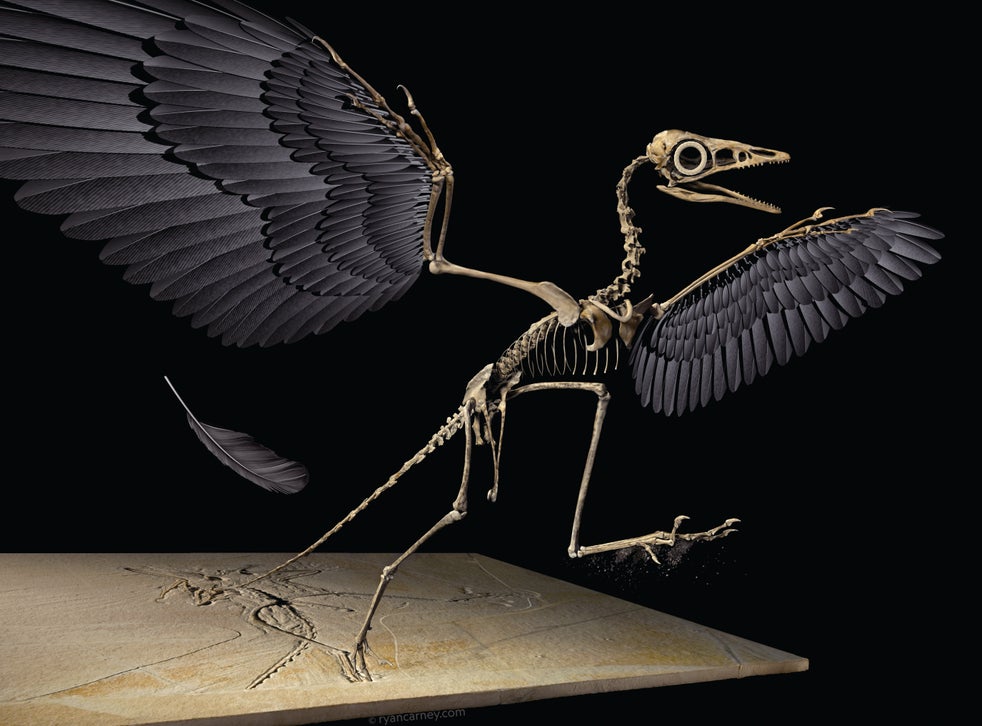
It looks like any feather you might find on the ground. But it’s about 150 million years old, and it fluttered to the ground back when the dinosaurs roamed what is today called Bavaria. It’s entombed in limestone and, when palaeontologists unearthed it in 1861, it became the first fossil feather ever discovered.
Many palaeontologists think the feather came from archaeopteryx lithographica, a creature that, with its feathered wings and sharp-toothed mouth, bears features of both dinosaurs and birds, making it a herald of the evolutionary transition between the two groups.
But that first-known fossil feather isn’t attached to an archaeopteryx skeleton - so for more than a century not all scientists have agreed on the identity of the feather’s owner.
“There’s been this debate, even when the feather was found: does this isolated feather belong to the same animal as these skeletal specimens of archaeopteryx?” said Ryan Carney, a palaeontologist and epidemiologist at the University of South Florida who has a tattoo of the feather on his arm.
In a study published last month in the journal Scientific Reports, Mr Carney and a team of colleagues compared the feather with the fossil remains of other feathers found with archaeopteryx fossils more recently, and they claim that the debate is now settled: the feather belongs to archaeopteryx.
Although the debate about whether the feather belonged to archaeopteryx has persisted, it came into greater focus in 2019 when other scientists argued in a paper that the feather might have belonged to another winged dinosaur species. Many scientists have been critical of this hypothesis, and Mr Carney and his team set out to counter it by studying the shape of the feather. They hoped to see whether it matched the anatomy of feathers that were still connected to other fossilised Archaeopteryx specimens.
They report that the feathers, for instance, have similar widths, lengths and curvatures. After overlaying an outline of the 1861 feather atop a fossil archaeopteryx wing, the team also found that the feather fits onto the wing perfectly. They additionally point out that the feather comes from the same fossil site as four archaeopteryx specimens later unearthed near Solnhofen, Germany.

Using a high-powered scanning electron microscope, the team also captured images of the feather with enough detail to reveal the presence of thousands of molecules called melanosomes — organelles responsible for the feather’s coloration — that preserve the feather’s original pigments. The pigments suggest that the feather was matte black in colour. What colour the rest of archaeopteryx was remains an open question.
Peter Wellnhofer, a palaeontologist at the Paleontological Museum in Munich who wrote a book about archaeopteryx and was not involved in the new research, said he was impressed by the study.
“They did not exclude different interpretations but put forward their own view, well-founded with new and convincing arguments,” he said.
Michael Pittman, a vertebrate palaeontologist at the University of Hong Kong and a co-author of the 2019 study, still thinks that the feather doesn’t fit, like a jigsaw puzzle piece in the wrong box. Although the feather could fit somewhere on archaeopteryx, it doesn’t mean that feather didn’t come from another dinosaur, he said. “We can’t rule out that another bird or other species didn’t drop the feather.”
Whether this paper settles the argument, Stephen Brusatte, a vertebrate palaeontologist at the University of Edinburgh, said studying the feather continues to offer useful insights.
“To me, ultimately, the important thing is that this feather belonged to a small-winged Jurassic animal that could fly pretty well, regardless of whether it was shed from the wing of archaeopteryx or another bird,” he said. “No doubt the warm, sunny lagoons of Jurassic Germany were aflutter with lots of flying dinosaurs.”
Whatever doubts anyone may still have, Mr Carney is so certain about his conclusion that he got a new tattoo right under his feather tattoo. It reads “Feder von Archaeopteryx lithographica”, which is German for “Feather of Archaeopteryx lithographica”, and is the text written on the slab of rock that bears the feather.
“Case closed on this question,” Mr Carney said.
New York Times







